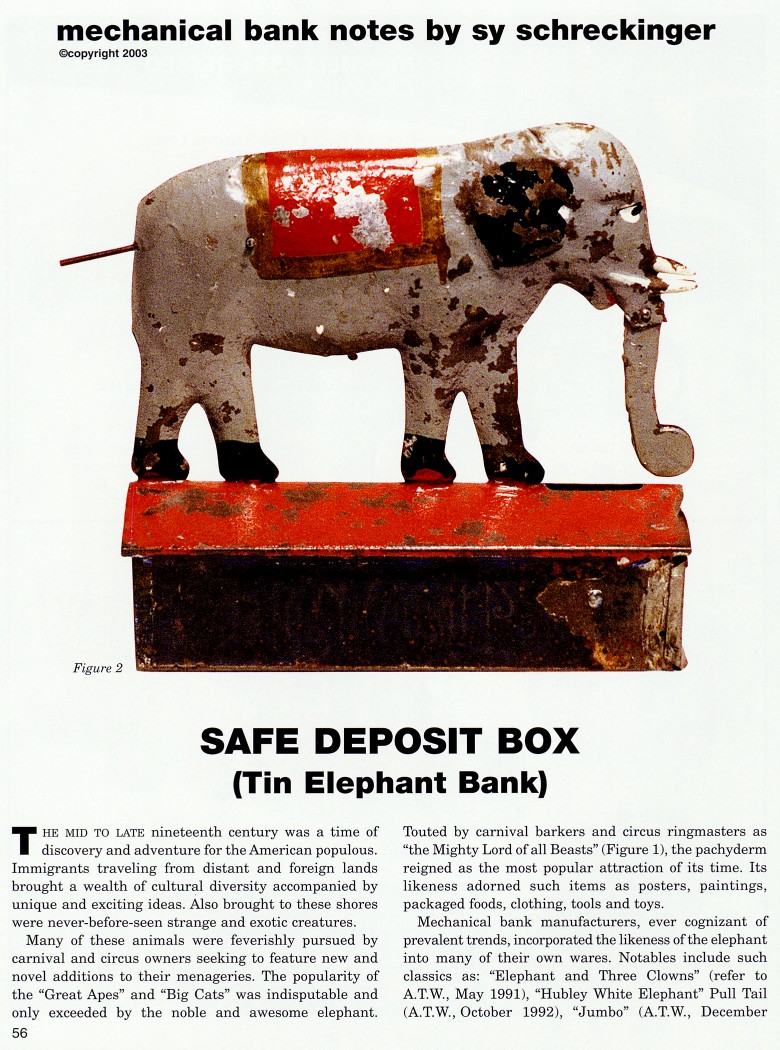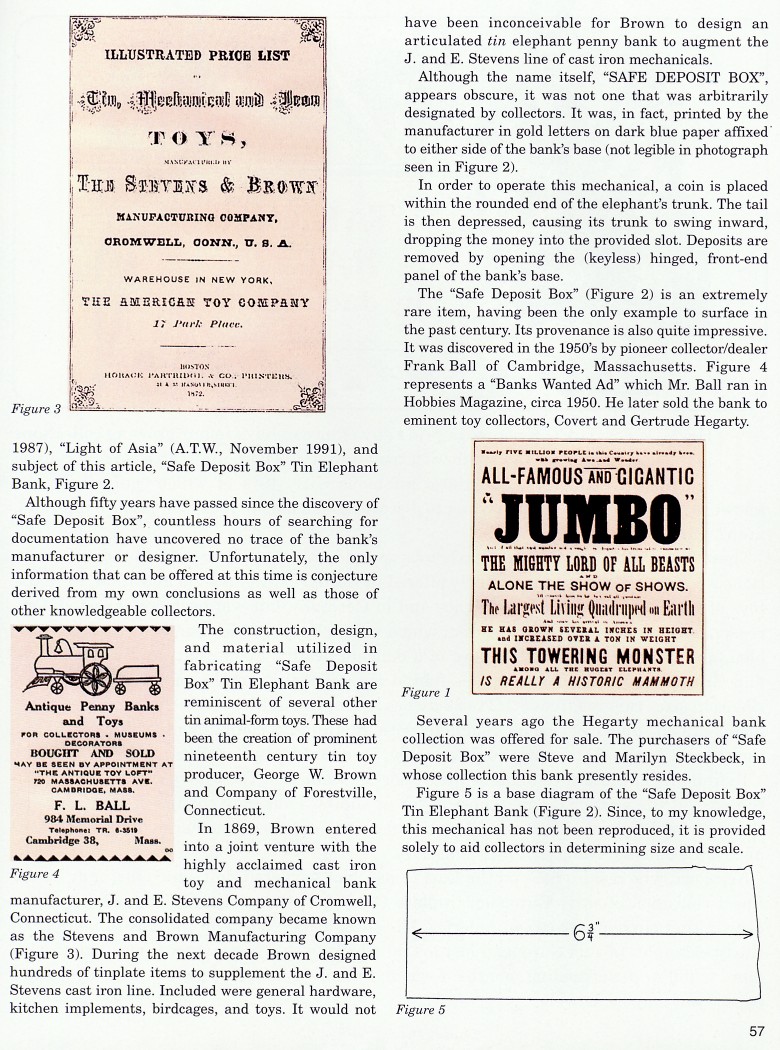|
Safe Deposit Box
(Tin Elephant bank)
by Sy Schreckinger – ANTIQUE TOY WORLD Magazine – May, 2003
The mid to late nineteenth century was a time of
discovery and adventure for the American populous. Immigrants traveling
from distant and foreign lands brought a wealth of cultural diversity
accompanied by unique and exciting ideas. Also brought to these shores
were never-before-seen strange and exotic creatures.
Many of these animals were feverishly pursued by carnival and circus
owners seeking to feature new and novel additions to their menageries. The
popularity of the "Great Apes" and "Big Cats" was indisputable and only
exceeded by the noble and awesome elephant. Touted by carnival barkers and
circus ringmasters as "the Mighty Lord of all Beasts" (Figure 1), the
pachyderm reigned as the most popular attraction of its time. Its likeness
adorned such items as posters, paintings, packaged foods, clothing, tools
and toys.
Mechanical bank manufacturers, ever cognizant of prevalent trends,
incorporated the likeness of the elephant into many of their own wares.
Notables include such classics as: "Elephant and Three Clowns" (refer to
A.T.W., May 1991), "Hubley White Elephant" Pull Tail (A.T.W.,
October
1992), "Jumbo" (A.T.W.,
December 1987), "Light of Asia" (A.T.W.,
November
1991), and subject of this article, "Safe Deposit Box" Tin Elephant Bank,
Figure 2.
Although fifty years have passed since the discovery of "Safe Deposit
Box", countless hours of searching for documentation have uncovered no
trace of the bank's manufacturer or designer. Unfortunately, the only
information that can be offered at this time is conjecture derived from my
own conclusions as well as those of other knowledgeable collectors.
The construction, design, and material utilized in fabricating "Safe
Deposit Box" Tin Elephant Bank are reminiscent of several other tin
animal-form toys. These had been the creation of prominent nineteenth
century tin toy producer, George W. Brown and Company of Forestville,
Connecticut.
In 1869, Brown entered into a joint venture with the highly acclaimed
cast iron toy and mechanical bank manufacturer, J. and E. Stevens Company
of Cromwell, Connecticut. The consolidated company became known as the
Stevens and Brown Manufacturing Company (Figure 3). During the next decade
Brown designed hundreds of tinplate items to supplement the J. and E.
Stevens cast iron line. Included were general hardware, kitchen
implements, birdcages, and toys. It would not have been inconceivable for
Brown to design an articulated tin elephant penny bank to augment the J.
and E. Stevens line of cast iron mechanicals.
Although the name itself, "SAFE DEPOSIT BOX", appears obscure, it was
not one that was arbitrarily designated by collectors. It was, in fact,
printed by the manufacturer in gold letters on dark blue paper affixed to
either side of the bank's base (not legible in photograph seen in Figure
2).
In order to operate this mechanical, a coin is placed within the
rounded end of the elephant's trunk. The tail is then depressed, causing
its trunk to swing inward, dropping the money into the provided slot.
Deposits are removed by opening the (keyless) hinged, front-end panel of
the bank's base.
The "Safe Deposit Box" (Figure 2) is an extremely rare item, having
been the only example to surface in the past century. Its provenance is
also quite impressive. It was discovered in the 1950's by pioneer
collector/dealer Frank Ball of Cambridge, Massachusetts. Figure 4
represents a "Banks Wanted Ad" which Mr. Ball ran in Hobbies Magazine,
circa 1950. He later sold the bank to eminent toy collectors, Covert and
Gertrude Hegarty.
Several years ago the Hegarty mechanical bank collection was offered
for sale. The purchasers of "Safe Deposit Box" were Steve and Marilyn
Steckbeck, in whose collection this bank presently resides.
Figure 5 is a base diagram of the "Safe Deposit Box" Tin Elephant
Bank (Figure 2). Since, to my knowledge, this mechanical has not been
reproduced, it is provided solely to aid collectors in determining size
and scale.
|


